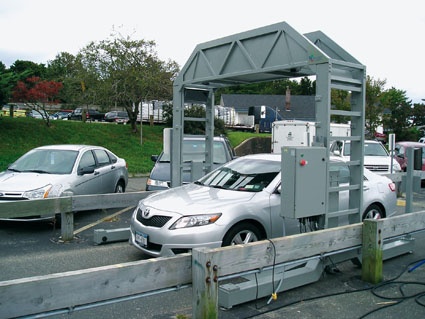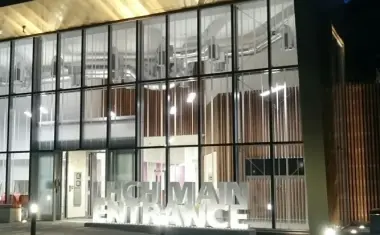Please Remain Seated
Frequent flyers don‘t think twice about walking through an archway at the airport to detect any metal that they are carrying. They are also used to handing over their hand luggage ...


Frequent flyers don‘t think twice about walking through an archway at the airport to detect any metal that they are carrying. They are also used to handing over their hand luggage to be scanned for illicit or dangerous substances. Some have now come to accept going through the controversial ‚body scanner‘ that provides airport security with a detailed view of the traveler‘s person, without them having to remove their clothing. But what about those travelling in vehicles? Until now, port authorities and security agents at sensitive locations and installations have either had to let most vehicles through unchecked, relying on their sixth sense to pull suspects out of the line or to do a time-consuming check of all vehicles.
Carscan is a new development by Spectrum from SAIC, San Diego, USA, that is distributed by the manufacturer's partner Secura Systems, a pan-European distributor of high-end security products and solutions. The product was developed with the financial assistance of the TSA, the Transport Security Agency, a US department of homeland security. The task was to build a device capable of viewing 100% of cars and small vans while ensuring a high traffic throughput and using only a tiny amount of X-ray radiation. It must be possible to look into concealed areas of the vehicles that could conceal explosives, money, drugs or even people.
The result is a mobile system that can be set up within a few hours by a small team. Thanks to its design, it fits into existing car lanes so that no earthworks, trenches or other building works are necessary. A small ramp is used to slow approaching vehicles down and the scan takes place as the vehicle drives through the archway.
Low Dose
People may complain at being subjected to a dose of X-rays but in fact the system emits a far smaller level of radiation - only up to around 0.1 microSievert (µSv) - just a small fraction of what we are naturally exposed to during a normal working day. This level corresponds to approximately 1/10,000th of a typical medical X-ray and can be safely ignored as a health factor. The use of the equipment complies with ANSI/HPS N43-17, the primary standard in the U.S. for general purpose security screening of humans using X-rays. The Carscan can also be used In Europe once national administrations have ratified the European standard IEC 62463 radiation protection instrumentation that was approved in September 2009 into their own legislation. This is already in progress in many European countries.
The trick to achieving usable images from such small radiation levels lies in the use of a patent-pending technique called K-Edge Switched Energy. This simultaneously screens the vehicle at two different energy levels and allows metal and organic objects to be distinguished. Organic threats such as explosives, drugs and even stowaways are shown on the control monitor in shades of yellow and red according to mass, as against metallic parts that show up in grey or black. The resultant image clearly shows the operator not only what sort of items are on board the vehicle but also their size and weight.
Go with the Flow
Wherever large numbers of vehicles come together there is inevitably congestion. This is only made worse when security levels are high and each vehicle must be manually inspected. Use of the Carscan will therefore be welcomed, for example, at vehicle entry points to defense installations, to critical infrastructures such as power plants, at airports and ferry terminals. Images from scanned vehicles are delivered within seconds, so approaching vehicles must only slow down to pass under the scanner gantry and must not stop unless the operator sees something suspicious. Traffic continues to move and congestion is minimized, even though every single vehicle is subjected to a complete scan.
The system is ideal for use not only at high traffic points such as customs and border controls but also to cover the ad-hoc requirements of the police for special events, at embassies or government buildings. It also interfaces with third-party systems, for example with the Simplicity C3 command and control software so it can be integrated into a larger configuration of security devices. A complete, more permanent installation might also include additional devices such as day/night camera systems, road blockers and automatic number plate recognition.
Business Partner
secura systemsFalkenhardt 10
49356 Diepholz
Germany
most read

The Benefits of AI-based Video Surveillance Solutions for Sports Venues
Dallmeier Interview: Artificial intelligence Makes Stadiums Smarter

Dormakaba: Smart Access with Spatial Experience
Smart Access at The Henderson Enabled by dormakaba Access Solutions

Liverpool Heart and Chest Hospital Transforms Security with Verkada’s Hybrid Cloud Technology
NHS Trust boosts safety and efficiency with Verkada’s cloud-managed cameras and AI-powered incident response

Airbus Defence and Space: Security as a strategic pillar of Europe's defense capability
Airbus Defence and Space protects sites, technologies and employees with modern security and cyber solutions - strengthening Europe's resilience in uncertain times

VIP-Lounge Interview: Marco Mille, Global Head of Security, Siemens AG
VIP in the World of Security: Marco Mille, Global Head of Security at Siemens AG










